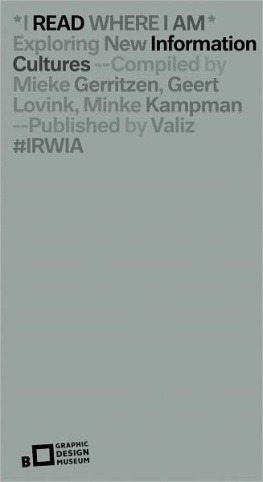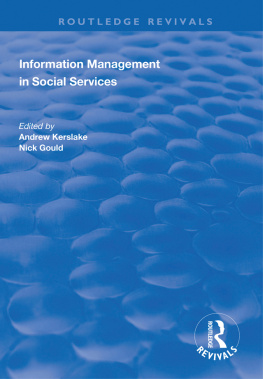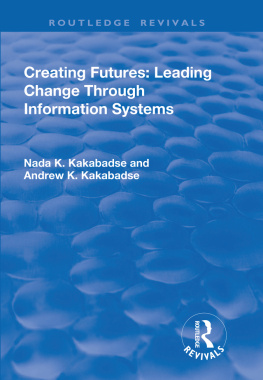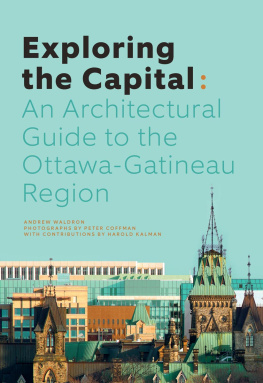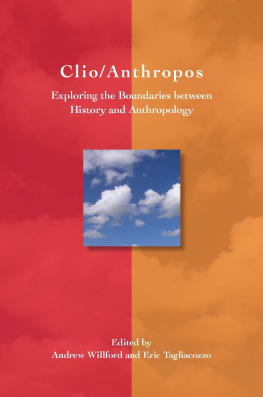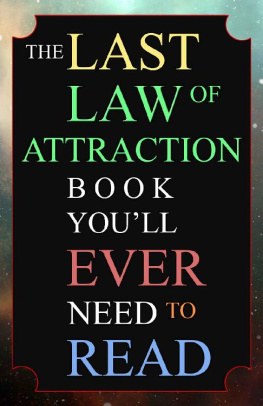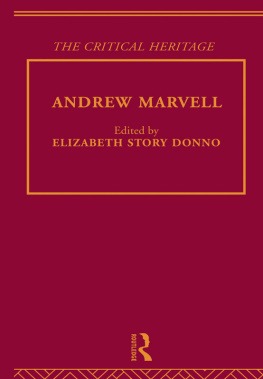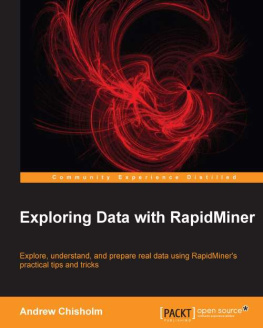Andrew Blauvelt (Author) - I Read Where I Am: Exploring New Information Cultures
Here you can read online Andrew Blauvelt (Author) - I Read Where I Am: Exploring New Information Cultures full text of the book (entire story) in english for free. Download pdf and epub, get meaning, cover and reviews about this ebook. genre: Art. Description of the work, (preface) as well as reviews are available. Best literature library LitArk.com created for fans of good reading and offers a wide selection of genres:
Romance novel
Science fiction
Adventure
Detective
Science
History
Home and family
Prose
Art
Politics
Computer
Non-fiction
Religion
Business
Children
Humor
Choose a favorite category and find really read worthwhile books. Enjoy immersion in the world of imagination, feel the emotions of the characters or learn something new for yourself, make an fascinating discovery.
- Book:I Read Where I Am: Exploring New Information Cultures
- Author:
- Genre:
- Rating:3 / 5
- Favourites:Add to favourites
- Your mark:
- 60
- 1
- 2
- 3
- 4
- 5
I Read Where I Am: Exploring New Information Cultures: summary, description and annotation
We offer to read an annotation, description, summary or preface (depends on what the author of the book "I Read Where I Am: Exploring New Information Cultures" wrote himself). If you haven't found the necessary information about the book — write in the comments, we will try to find it.
I Read Where I Am: Exploring New Information Cultures — read online for free the complete book (whole text) full work
Below is the text of the book, divided by pages. System saving the place of the last page read, allows you to conveniently read the book "I Read Where I Am: Exploring New Information Cultures" online for free, without having to search again every time where you left off. Put a bookmark, and you can go to the page where you finished reading at any time.
Font size:
Interval:
Bookmark:
Various
I Read Where I Am. Exploring New Information Cultures
Various
I Read Where I Am. Exploring New Information Cultures
Introduction
We are street readers. Look at us, info junk dealers, as we zip through the telephone, scan a newspaper weve just read, leaf through a magazine. We are the new generation of readers. Not dumber, just faster. We whiz through three lives at once. Lets be honest: reading has become a different experience. Reading has become looking and vice versa. Information has become tactile. You dont have to remember anything, you just look it up. Could it be that the average person (still) doesnt like reading? Can you call what people do on Facebook and Twitter reading? Absorbing books and newspapers was something from which you traditionally became wiser, because unusual opinions, special thoughts, new developments, and fantasies were revealed. But there have always been good and bad books. Quality and pulp have always existed.
We are info junkies. People dont know where to draw the line and, in todays consumer society, are constantly fighting for control. Information, following food and the environment, may be next in line for an analysis on sustainable development. Information has become a consumer product because it is linked to the form in which it appears. New platforms and formats are appearing with greater frequency on the market. Text, video, sound, and graphics intermingle. Everybody is busy answering, uploading.
We all know the main lines of info evolution, from the printing press to the iPhone. By now the information is drifting through space and there are new tools for reading and writing, which each time combine the multimedia mix in a different way. Each change is in itself large and has consequences for the economy, politics, and the social status of our existence.
In I Read Where I Am the Graphic Design Museum , together with the Institute for Network Cultures, investigates recent developments in the field of information design. The book is produced under the Infodecodata programme, an exhibition about information design that was launched in 2010 in the Graphic Design Museum . Infodecodata presents new developments on the cusp of text and image.
Much discussion took place in the twentieth century about the relationship between art and science, but it often did not go further than good intentions. Engineers do not want to involve artists in crucial stages of the research and artists in turn are all too determined to remain autonomous. But now we see them actually coming closer together. This has not happened because good intentions have all at once been turned into deeds. It is the technology itself that develops form and content simultaneously and considers it to be a whole. Different types of content and readers ask for different forms and experiences. The question remains: which form will it assume and what experience do you want?
In I Read Where I Am, 82 invited authors, artists, critics, and designers present a wide range of observations, inspirations, and critical notes about how we daily consume and produce our information. We intended to leave the justified nostalgia for what it is and asked the expert-amateurs to look further than the current hype around the iPads and Kindles. This publication does not only reflect the current state of affairs but also speculates about the significance and importance of new forms of image-text in the future. Let us together place them in the world and not wait for ready-made products from Silicon Valley . The reflections presented here are explicitly intended to be read as a guideline for the following generations of reading machines. All that remains is for us to design them without losing our attention.
Mieke Gerritzen is designer and director of the GraphicDesignMuseum.
Geert Lovink is media theorist, net critic and director of the Amsterdam-based Institute of Network Cultures .
Essays by:
Arie Altena
Henk Blanken
Erwin Blom
James Bridle
Max Bruinsma
Anne Burdick
Vito Campanelli
Catalogtree
Florian Cramer
Sean Dockray
Paulien Dresscher
Dunne amp; Raby
Sven Ehmann
Martin Ferro-Thomsen
Jeff Gomez
Denise Gonzales Crisp
Alexander Griekspoor
Hendrik-Jan Grievink
Ger Groot
Gary Hall
John Haltiwanger
N. Katherine Hayles
Toon Horsten
Minke Kampman
Lynn Kaplanian-Buller
Kevin Kelly
Joost Kircz
Matthew Kirschenbaum
Tanja Koning
Steffen Konrath
Erin La Cour
Rudi Laermans
Warren Lee
Jannah Loontjens
Alessandro Ludovico
Peter Lunenfeld
Ellen Lupton
Anne Mangen
Lev Manovich
Luna Maurer
Geert Mul
Arjen Mulder
Caroline Nevejan
David B. Nieborg
Kali Nikitas
Henk Oosterling
David Ottina
Peter Pontiac
Ine Poppe
Emilie Randoe
Bernhard Rieder
Paul Rutten
Johan Sanctorum
Louise Sandhau
Niels Schrader
Ray Siemens
Karin Spaink
Erik Spiekermann
Matthew Stadler
F. Starik
Bob Stein
Michael Stephens amp; Jan Klerk
Carolyn Strauss
Dick Tuinder
Lian van de Wiel
Bregtje van der Haak
Els van der Plas
Rick van der Ploeg
Daniel van der Velden
Adriaan van der Weel
Erwin van der Zande
Ren van Engelenburg
Francisco van Jole
Peter van Lindonk
Koert van Mensvoort
Tjebbe van Tijen
Dirk van Weelden
Jack van Wijk
Astrid Vorstermans
McKenzie Wark
Simon Worthington
1. Gathering Up Characters Arie Altena
Reading behaviour changes, also because of the influence of technology. Empirical research has shown that a screen-based reading behaviour has arisen because we are online so much and read from the screen. A characteristic of this reading behaviour is that more time is spent on browsing, scanning, and identifying key words. Reading is selective, things are not read more than once, and it is generally non-linear. It is said to be at the expense of concentrated and in-depth reading.
Thats probably right. Readers in the richer countries read more and more from the screen. The developments of the past twenty-five years have been just as radical as those following the invention of book printing. With the transition from printed material to digital text, there was, to a certain degree, a shift from owning text to accessing text; from a book or magazine that you hold in your hand, to access to text in the cloud the internet via an appliance. (I write to a certain degree because in the past the access to text was primarily for professional readers: you had to be in the library.)
How, then, will we read in the future? No different than in the past at least as long as its about converting word images into something with linguistic meaning. That people are reading more from the screen doesnt, of course, mean that concentrated reading is a thing of the past, or that nobody ever reads out loud. When reading selectively, scanning, the word image is converted into meaning. After seventeen to eighteen years of screen reading, the question of how you ensure a concentrated reading experience in the current and future media ecology still fascinates me.
I am still not really impressed by the e-readers (the format misery is still a long way from being solved) and the tablets (you cant read from a reflective screen in the sun). The e-readers have a problem with access, the tablets one with ergonomics. It is getting better but slowly.
I hope that in fifty years we are using reading appliances and accounts in the cloud that individuals are completely in charge of, and that there are no organizations that check and log what bytes you download, analyze it in real time, sell on the data, and save it. Or at least, should that happen and it will happen; that it will benefit to the customer and that alternatives will also exist. I hope that use will be made of simple data formats and of simple software. I hope that a free circulation of knowledge takes place.
Font size:
Interval:
Bookmark:
Similar books «I Read Where I Am: Exploring New Information Cultures»
Look at similar books to I Read Where I Am: Exploring New Information Cultures. We have selected literature similar in name and meaning in the hope of providing readers with more options to find new, interesting, not yet read works.
Discussion, reviews of the book I Read Where I Am: Exploring New Information Cultures and just readers' own opinions. Leave your comments, write what you think about the work, its meaning or the main characters. Specify what exactly you liked and what you didn't like, and why you think so.

